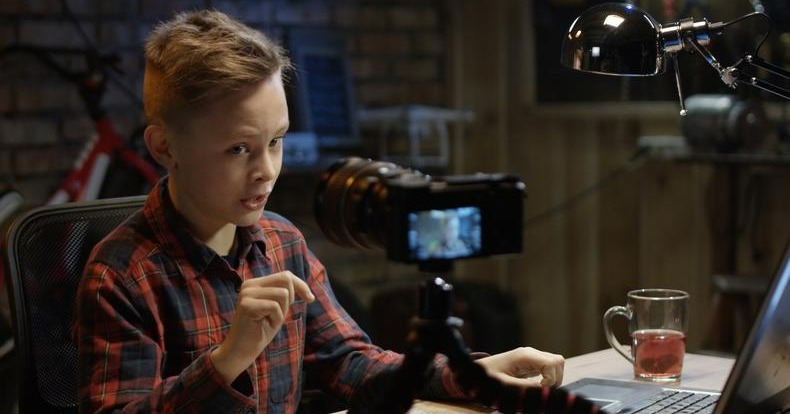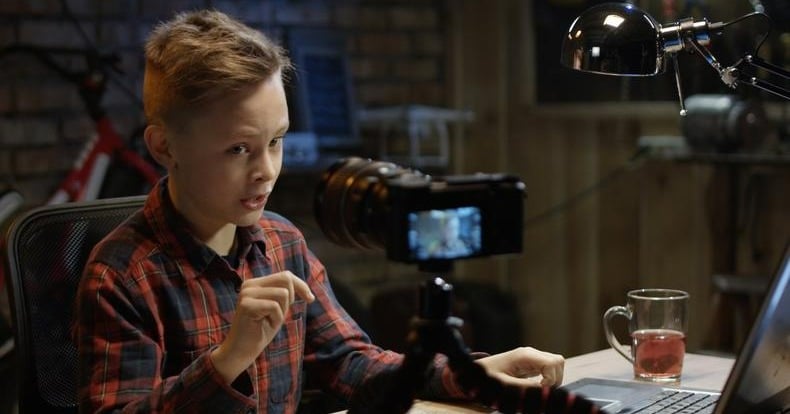How Voice Cloning Helps Children’s Content Creators Generate More Content

It's no secret that the market for children's content is constantly changing and evolving. In 2022, we've seen an explosion of new trends, ranging from augmented reality experiences to interactive stories and personalized educational apps. But what can we expect from this fast-paced AI generated content industry in 2023 and 2024? In this blog post, we'll explore some of the trends related to ethical voice cloning and discuss the impact these considerations, alongside AI generated content, will have on these developments.
2023-2024 children’s content trends
Voice conversion, personalized experiences, interactive storytelling, augmented reality (AR), and virtual reality (VR) are all likely to become more commonplace in the children's content arena with a growing emphasis on AI ethics.
Additionally, there will be an emphasis on developing educational tools and resources that are tailored to individual interests, creating greater engagement and enabling children to learn at their own pace, integrating speech synthesis for enhanced interactive experiences while adhering to stringent AI ethics standards. As a result, language learning apps, educational games, and coding initiatives will continue to grow in popularity amongst parents and teachers alike, incorporating innovative speech synthesis technologies.
Finally, as streaming services become increasingly accessible, original content for children is expected to boom, further showcasing the value of originality and creativity when it comes to designing fun and captivating content for younger generations.
While the digital content market for children is expanding due to the introduction of new technologies, the space is currently dominated by interactive games, educational videos found on YouTube, and online virtual museum tours with integrated speech synthesis features.
-
Games provide an opportunity for creative problem-solving, enabling young minds to develop strategizing skills and hone their motor functions.
-
While entertaining, Youtube channels also offer a learning experience, with many creators devoted to teaching various topics such as science, mathematics, spelling, and so on, utilizing speech synthesis to enhance educational content.
-
Visiting a museum's website allows children to virtually traverse its exhibitions without ever having to leave home - cultivating curiosity about the world around them.
YouTube content creators for kids: who are they?
Famous kids content creators on YouTube include family vloggers like The Ace Family. Blippi is known for their educational and entertaining videos, and Ryan's World is one of the most popular toy reviewers.
Other famous YouTubers for kids are influencers like Mila Stauffer and Emma Stauffer, Everleigh Rose, and The Fishfam channel with Taytum & Oakley Fisher sisters.
Despite the success of these YouTube content creators, all of their content entails having to film children, and that means having to confront the difficulties that go along with doing so.
Working with children on set is both easy and challenging at the same time. Children get tired faster than adults, and they can’t spend days and nights on set. Sincere child-like emotions and acting combine with fickle moods and problems with concentration, which can make voice acting a difficult process. The smaller the child, the more challenges the crew will face filming the child in the way their film demands.
Even seasoned actors encounter difficulty when it comes to re-dubbing episodes of a film that has already wrapped shooting. With children voice actors, things are even more complicated.
Virtual YouTubing is another popular niche for kids. It has been around for some time now, having first emerged in the early 2010s. It involves using avatars to create videos and live streams on YouTube, allowing content creators, including children voice actors, to remain anonymous while still being able to engage with their audiences. Initially, Virtual YouTubers were mostly limited to Japan, but over the years, they have become increasingly popular all over the world. AI generated content has become an integral part of this landscape.
Today, there is an abundance of different Virtual YouTubers – from humanoid robots to furry animals – that generate content on a variety of topics (these range from gaming to cooking and even comedic skits). Viewers enjoy these avatars' unique personalities and connect with them on a deeper level than when watching traditional YouTubers.
However, Virtual YouTubing is not without its challenges. Since it relies heavily on technology, it's prone to glitches which can be highly distracting for viewers. Additionally, since the Vtuber’s identity is hidden, building trust between an avatar and the audience takes much longer.
How does voice synthesis help children's content creators?
Voice synthesis can be a powerful asset for YouTube content creators looking to connect with their audience. AI voice cloning can simulate human-like speech and give life to audio presentations that would otherwise lack personality. This feature makes it possible to add an extra layer of emotion and intrigue to video content, creating a more engaging experience for viewers.
Additionally, voice synthesis the convenience of allowing creators to produce recordings quickly with no need for re-recording. It is also an effective tool for providing localized versions of videos as it enables content producers to transcribe videos into different languages easily and accurately.
Voice conversion helps children’s content creators overcome the following challenges:
-
Burnout. Voice cloning reclaims most of the working hours demanded of kid actors in a studio. Any member of your team can dub audio content and then have kids’ voices easily cloned to match theirs. The best part is that all this can be done while actors enjoy a well-deserved vacation.
-
Lack of time and resources to produce new content. Managers of large YouTube projects know that their audience is ready to consume significantly more content than they can afford to release. To a large extent, restrictions on production are explained by the fact that a channel is tied to one or two hosts. And people are always a risk factor.
As with burnout, voice cloning services can help bring a large team together for content production. This is because production teams no longer have to depend on an actor’s physical presence in a studio. -
Running out of video ideas. This is perhaps one of the main problems for those who create content. How else to surprise an audience? — it is the central question behind a channel's success.
With voice cloning, a third party can now speak using your voice or a channel’s host can speak using the voices of other people after getting the permission to use their voice. Imagine a famous blogger suddenly starts speaking in the voice of an equally famous YouTuber. Or, for example, they begin to speak in the voice of an iconic superhero.
-
Challenges working with children. With speech-to-speech technology, a child may not be available for additional dialogue replacement (ADR). With Respeecher, it is enough to record one hour of a child actor’s voice so that an adult can then read the dialog for them.
Using a 5+ minute recording as a reference, any voice can be synthesized into the child's while retaining all the shades of emotion, accent, and characteristics of their speech. This means that sound directors no longer have to summon a child actor to the studio with their parents. Respeecher’s voice cloning tech also empowers producers to create and maintain the voice of a content character at the same age for many years.
In conclusion
AI ethics play a crucial role in the realm of children's content creation, as responsible utilization of technologies like voice cloning becomes paramount. As you can see, children’s content creators can greatly benefit from AI speech synthesis. If you run a YouTube channel, create podcasts, or generate other types of content for children and are interested in the prospect of using voice cloning in your work with a strong commitment to AI ethics, contact us today.
Respeecher cooperates with both large Hollywood studios and popular YouTube stars, ensuring that ethical voice cloning practices are maintained in each collaboration. We also have our own Voice Marketplace, making the licensing process more accessible and lowering the barriers to entry for smaller video studios and independent creators.
FAQ
Generative AI technologies create content like images, text, or audio by learning patterns from data. Voice synthesis software and AI voice cloning are key tools, utilizing speech synthesis technology to generate human-like audio. These technologies support applications in entertainment, AI-driven engagement, and personalized experiences.
Adobe Photoshop has reshaped creativity by allowing designers to manipulate images and graphics seamlessly. Similar to generative AI in content creation, AI-driven engagement in digital arts enables voice synthesis and deepfake audio technology to enhance visual storytelling and synthetic media production.
Ethical concerns in speech synthesis technology include misuse in deepfake audio, voice cloning risks, and manipulative media tools. Ensuring ethical principles for AI safeguards privacy, consent, and the avoidance of harmful synthetic media is crucial to maintaining trust and transparency in the industry.
Generative AI in entertainment can enhance creativity by producing AI voice cloning and deepfake audio technology for ethical media creation. Adhering to AI ethics ensures voice cloning is used responsibly, protecting creators' rights and avoiding harmful manipulation or misrepresentation of individuals.
Legal frameworks for voice cloning technology focus on intellectual property, AI ethics, and privacy laws. Consent is essential for AI voice cloning use, and deepfake audio technology may require regulations to prevent misuse in manipulative media tools and unauthorized voice synthesis.
Common use cases for voice synthesis software include AI voice cloning for content creation, text-to-speech advancements, and AI-driven engagement in digital coaching. It enhances accessibility, aids in audio localization, and allows generative AI to produce dynamic, personalized audio content at scale.
Distinguishing AI-generated audio from real content often involves listening for unnatural patterns or inconsistencies. Advanced deepfake audio technology and AI voice cloning can make it challenging, but synthetic media ethics encourages watermarking technology and other tools to help ensure transparency and authenticity.
Risks of generative AI technologies include voice cloning risks, deepfake audio misuse, and the potential for manipulative media tools. The absence of clear ethical principles for AI may lead to privacy breaches, misinformation, and the exploitation of AI-driven engagement in harmful ways, necessitating careful regulation.
Glossary
Generative AI technologies
Generative AI technologies use speech synthesis technology and AI voice cloning to create human-like content. They raise ethical concerns such as voice cloning risks and manipulative media tools in areas like entertainment and deepfake audio technology.
Adobe Photoshop controversies
Adobe Photoshop controversies involve the use of Generative AI technologies for image manipulation, raising ethical concerns about synthetic media ethics, manipulative media tools, and AI voice cloning risks.
Speech synthesis software
Speech synthesis software uses Generative AI technologies to convert text into speech, enabling AI voice cloning, text-to-speech advancements, and raising synthetic media ethics concerns.
Voice cloning risks
Voice cloning risks include potential misuse in deepfake audio technology, ethical concerns in voice cloning, and challenges related to synthetic media ethics and manipulative media tools.
Text-to-speech technology
Text-to-speech technology uses speech synthesis technology to convert written text into spoken words, enabling AI voice cloning and generative AI applications with ethical considerations.
AI in entertainment
AI in entertainment uses generative AI technologies like AI voice cloning and speech synthesis technology to create immersive experiences, raising ethical concerns in the media.
Ethical AI principles
Ethical AI principles guide the responsible use of generative AI technologies like AI voice cloning, ensuring synthetic media ethics and mitigating voice cloning risks.






